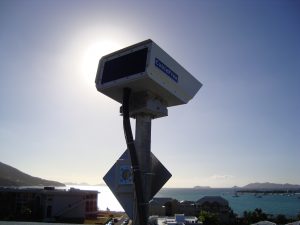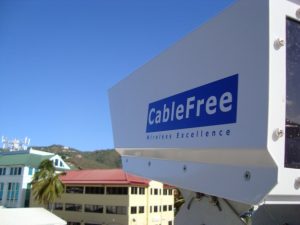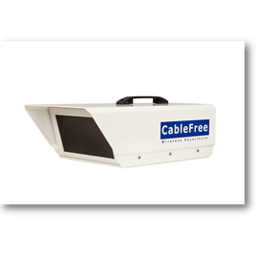What is FSO? FSO: Optical or Wireless Market Challenges
The Technology Behind Optical Wireless

Imagine a technology that offers unsurpassed reliability and high-speed connectivity. A technology that can be installed globally, is easy to deploy, license-free and offers a fast, high ROI. That technology is free-space optics (FSO). This line-of-sight technology approach uses lasers to provide optical bandwidth connections. It’s capable of sending up to 2.5 Gbps of data, voice, and video communications simultaneously through the air — enabling optical connectivity without requiring fiber-optic cable or securing spectrum licenses. It enables optical communications at the speed of light. And it forms the basis of a new category of products — optical wireless products from CableFree, the recognized leader in optical wireless communications.
This site is intended to provide valuable background and resource information on FSO technology. Whether you’re a student, an engineer, account manager, partner, or customer, this site provides the FSO insight you may require. And for providing high-speed, “last-mile” connections, across campuses and into fiber networks, it is the best technology available.
Free-space optics (FSO) is a line-of-sight technology that uses lasers to provide optical bandwidth connections that can send and receive voice, video, and data information on invisible beams of light. Today, FSO technology — the foundation of CableFree’s optical wireless offering — has enabled the development of a new category of products that can transmit voice, data, and video at bandwidths up to 2.5 Gbps at distances up to 4 km, over any protocol. This optical connectivity doesn’t require expensive fiber-optic cable or securing spectrum licenses. FSO technology requires light, which can be focused by using either light emitting diodes (LEDs) or lasers (light amplification by stimulated emission of radiation). The use of lasers is a simple concept similar to optical transmissions using fiber-optic cables; the only difference is the medium. Light travels through air faster than it does through glass, so it is fair to classify FSO technology as optical communications at the speed of light.
History of Free Space Optics
Originally developed by the military and NASA, FSO has been used for more than 30 years to provide fast communication links in remote locations. CableFree has extensive experience in this area: its experts were in the labs developing prototype FSO systems in Europe mid ’90s, before others had even started to think about the technology.
While fiber-optic communications has gained acceptance in the telecommunications industry, FSO communications is still relatively new. FSO technology enables bandwidth transmission capabilities that are similar to fiber optics, using similar optical transmitters and receivers and even enabling WDM-like technologies to operate through free space.
What is FSO History How it Works FSO: Optical or Wireless Market Challenges

How it Works
FSO technology is surprisingly simple. It’s based on connectivity between FSO-based optical wireless units, each consisting of an optical transceiver with a laser transmitter and a receiver to provide full-duplex (bi-directional) capability. Each optical wireless unit uses a high-power optical source (i.e. laser), plus a lens or telescope that transmits light through the atmosphere to another lens receiving the information. At this point, the receiving lens or telescope connects to a high-sensitivity receiver via optical fiber.
This FSO technology approach has a number of advantages:
Requires no spectrum licensing.
Is easily upgradeable, and its open interfaces support equipment from a variety of vendors, which helps enterprises and service providers protect their investment in embedded telecommunications infrastructures.
Requires no security software.
Is immune to radio frequency interference or saturation.
Can be deployed behind windows, eliminating the need for costly rooftop rights.
What is FSO? History How it Works FSO: Optical or Wireless? Market Challenges
FSO: Optical or Wireless?
Speed of fiber — flexibility of wireless.

Optical wireless, based on FSO-technology, is an optical technology that provides the speed of fiber, with the flexibility of wireless. It enables optical transmission at speeds of up to 2.5 Gbps and, in the future, 10 Gbps using WDM. This is not possible with any fixed wireless/RF technology today. Optical wireless also obviates the need to buy expensive spectrum (it requires no FCC or municipal license approvals), which further distinguishes it from fixed wireless technologies. Moreover, its narrow beam transmission is typically two meters versus 20 meters and more for traditional, even newer radio-based technologies such as millimeter-wave radio. Optical wireless products’ similarities with conventional optical solutions enable the seamless integration of access networks with optical core networks and helps to realize the vision of an all-optical network.
What is FSO? History How it Works FSO: Optical or Wireless? Market Challenges
Market Perspective:

Fueled by the ever-increasing demand for more bandwidth of enterprise customers and service providers, the global “last mile” has become a significant opportunity. While many companies are within range of fiber-optic cable, most are not adequately connected as a result of prohibitive licensing requirements and the expense of having to dig up streets and neighborhoods. To date, fewer than 10 percent of buildings worldwide are connected by fiber — yet 70 percent are within a mile of a fiber connection. As bandwidth demands increase and businesses turn to high-speed LANs, it has become even more frustrating to be connected to the outside world through lower-speed connections such as DSL, cable modems, or T1s.
Further, most of the recent trenching to lay fiber has been to improve the metro core (backbone), while the metro access and edge — the ” last mile” — have been ignored. Studies show that gaps occur in the metro network core, primarily due to cost constraints and the deployment of non-scalable, non-optical technologies such as LMDS. Metro optical networks have not yet delivered on their promise. High capacity at affordable prices still eludes the ultimate end-user.
Market Opportunity:
IDC reports that the worldwide metro Ethernet market, driven by Asia, will exceed $5 billion in value by 2003, and reach a staggering $25 billion in 2006. Frost & Sullivan sees the U.S. optical Ethernet market growing at a 59 percent CAGR to more than $4 billion by 2007.
There’s a huge market opportunity — but which technology can best address the connectivity bottleneck? Fiber optic? Radio frequency? Wire and copper-based technologies or FSO?
Fiber Optic Cable:
It’s the most obvious first choice. Without a doubt, fiber is the most reliable means of providing optical communications. But the digging, delays, and associated costs to lay fiber often make it economically prohibitive. Moreover, once fiber is deployed, it becomes a “sunk” cost and cannot be re-deployed if a customer relocates or switches to a competing service provider, making it extremely difficult to recover the investment in a reasonable timeframe.
Radio Frequency
Another option is radio frequency (RF) technology. RF is a mature technology that offers longer-range distances than FSO, but RF-based networks require immense capital investments to acquire spectrum license. Also, RF technologies do not scale to gigabit speeds, and are not immune to interference and saturation in heavily congested RF environments. When compared to FSO-based optical wireless offerings, RF does not make economic sense for service providers or enterprises looking to extend optical networks.
Wire and Copper
This option includes wire- and copper-based technologies, (i.e. cable modem, T1s or DSL). Although copper infrastructure is available almost everywhere and the percentage of buildings connected to copper is much higher than fiber, it is still not a viable alternative for solving the “last mile” connectivity bottleneck. The biggest hurdle is bandwidth scalability. Copper technologies may ease some short-term pain, but the bandwidth limitations of 2 megabits to 3 megabits makes them a marginal solution, even on a good day.
FSO technology — the “last mile” connectivity answer
The most viable alternative is FSO technology. It offers the speed of fiber with the flexibility of wireless. Given its optical foundation, bandwidth scalability, speed of deployment (hours versus weeks or months), re-deployment and portability, and cost-effectiveness (on average, one-fifth the cost of installing fiber-optic cable), FSO technology is the perfect choice for today’s optical wireless products. Further, its layer one transparency ensures interoperability with all major networking vendor switches, routers, and other equipment.
Optical wireless products, based on FSO technology, are offering cost-effective, last-mile connectivity solutions to enterprises and service providers — handling connectivity across campuses, and into fiber networks. There are three market segments poised for significant growth:
Enterprise campus networks — for companies of all sizes that need to connect buildings across campuses and need access to fiber backbones.
Wireline access — aimed at service providers looking for an alternative to fiber, especially where expensive leased lines are the only current available solution, and in regions with rapidly developing infrastructure-China and India.
Mobile Wireless — includes mobile wireless backhaul for today’s networks and next-generation architectures.
Click here to view the FSO Technology Shift Zone — a timeline and market growth graphic showing FSO technology adoption.
What is FSO? History How it Works FSO: Optical or Wireless? Market Challenges Top
Challenges
While fiber-optic cable and FSO technology share many of the same attributes, they face different challenges due to the way they transmit information. While fiber is subject to outside disturbances from wayward construction backhoes, gnawing rodents, and even sharks when deployed under sea, FSO technology is subject to its own potential outside disturbances. Optical wireless networks based on FSO technology must be designed to combat changes in the atmosphere, which can affect FSO system performance capacity. And because FSO is a line-of-sight technology, the interconnecting points must be free from physical obstruction and able to “see” each other.
All potential disturbances can be addressed through thorough and appropriate network design and planning. Among the issues to be considered when deploying FSO-based optical wireless systems:
Fog: The primary challenge to FSO-based communications is fog. Rain and snow have little effect on FSO technology, but fog is different. Fog is vapor composed of water droplets, which are only a few hundred microns in diameter but can modify light characteristics or completely hinder the passage of light through a combination of absorption, scattering, and reflection. The primary answer to counter fog when deploying FSO-based optical wireless products is through a network design that shortens FSO link distances and adds network redundancies. FSO installations in extremely foggy cities such as San Francisco have successfully achieved carrier-class reliability.
Absorption: Absorption occurs when suspended water molecules in the terrestrial atmosphere extinguish photons. This causes a decrease in the power density (attenuation) of the FSO beam and directly affects the availability of a system. Absorption occurs more readily at some wavelengths than others. However, the use of appropriate power, based on atmospheric conditions, and use of spatial diversity (multiple beams within an FSO-based unit) helps maintain the required level of network availability.
Scattering: Scattering is caused when the wavelength collides with the scatterer. The physical size of the scatterer determines the type of scattering. When the scatterer is smaller than the wavelength, this is known as Rayleigh scattering. When the scatterer is of comparable size to the wavelength, this is known as Mie scattering. When the scatterer is much larger than the wavelength, this is known as non-selective scattering. In scattering — unlike absorption — there is no loss of energy, only a directional redistribution of energy that may have significant reduction in beam intensity for longer distances.
Physical obstructions: Flying birds or construction cranes can temporarily block a single-beam FSO system, but this tends to cause only short interruptions, and transmissions are easily and automatically resumed. CableFree’s optical wireless products use multi-beam systems (spatial diversity) to address temporary obstructions, as well as other atmospheric conditions, to provide for greater availability.
Building sway/seismic activity: The movement of buildings can upset receiver and transmitter alignment. CableFree’s FSO-based optical wireless offerings use a divergent beam to maintain connectivity. When combined with tracking, multiple beam FSO-based systems provide even greater performance and enhanced installation simplicity.
Scintillation: Heated air rising from the earth or man-made devices such as heating ducts create temperature variations among different air pockets. This can cause fluctuations in signal amplitude which leads to “image dancing” at the FSO-based receiver end. CableFree’s unique wide-beam optics is designed to address the effects of this scintillation. Called “Refractive turbulence,” this causes two primary effects on optical beams
Beam Wander: Beam wander is caused by turbulent eddies that are larger than the beam.
Beam Spreading: Beam spreading — long-term and short-term — is the spread of an optical beam as it propagates through the atmosphere.
Safety: To those unfamiliar with FSO technology, safety can be a concern because the technology uses lasers for transmission. The proper use and safety of lasers have been discussed since FSO devices first appeared in laboratories more than two decades ago. The two major concerns involve eye exposure to laser beams and high voltages within the laser systems and their power supplies. Strict international standards have been set for laser safety and performance, and CableFree’s optical wireless systems comply with these standards.
For Further Information
For more information on Carrier Class FSO, please Contact Us
You must be logged in to post a comment.